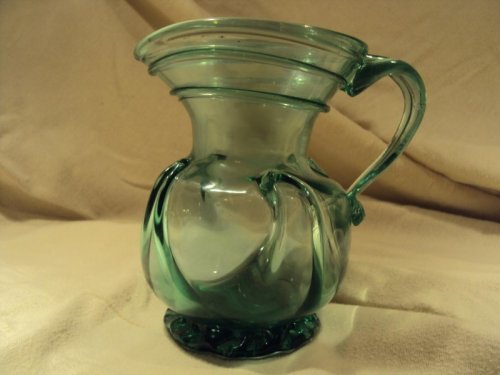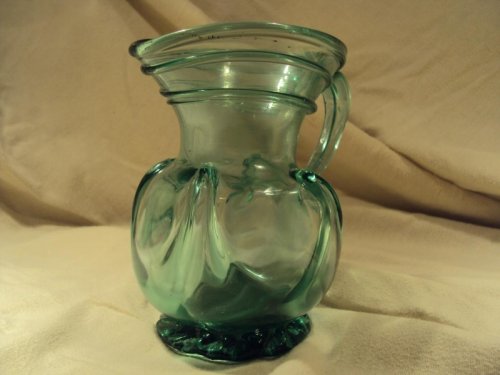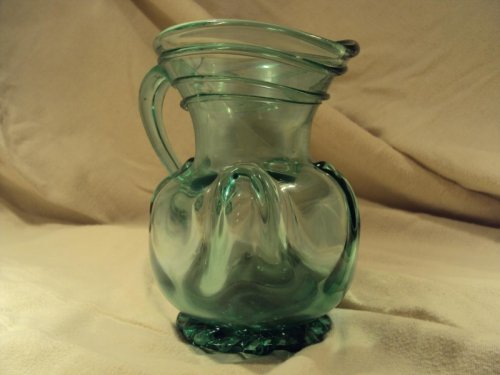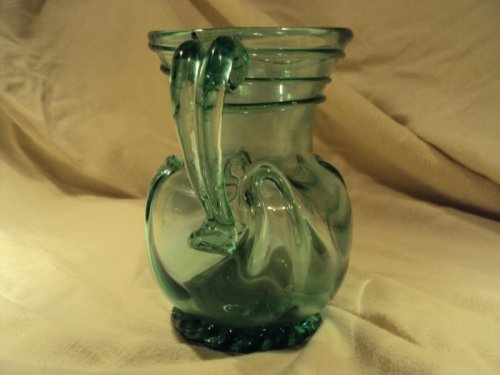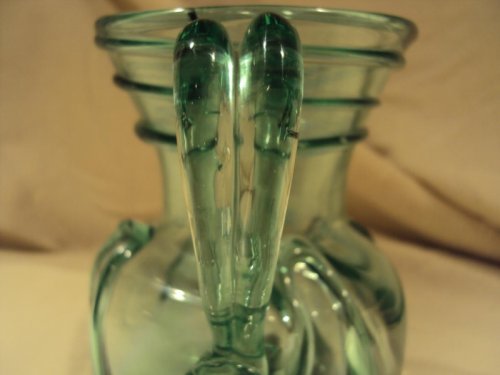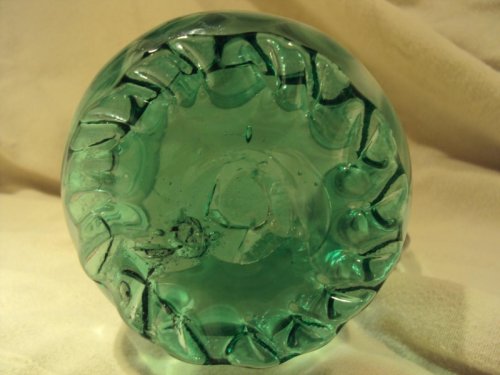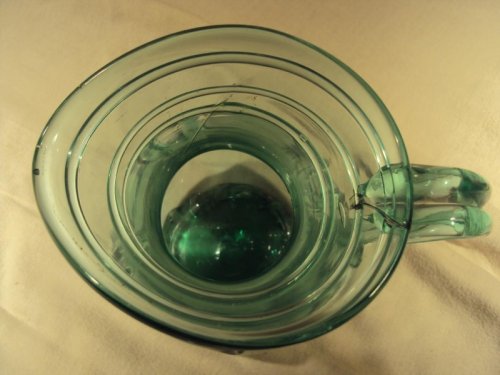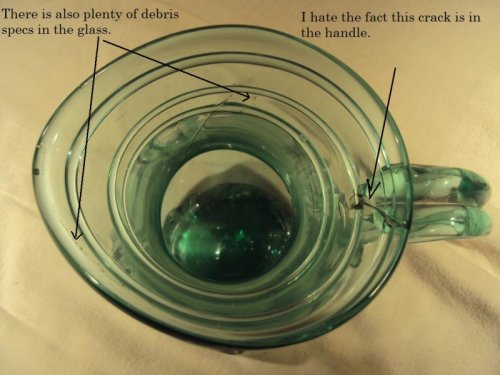Steve/sewell
Well-Known Member
- Joined
- Jan 23, 2010
- Messages
- 6,108
- Reaction score
- 5
- Points
- 0
Here is a good example of a South Jersey Lily pad type one,two and three pitcher.
It dates from the 1830 to 1840 time period.The color is a nice light apple green.The pitcher has type1 type 2
and type 3 lily-pad characteristics.
It has a crimped base used on pre 1850. Threaded at the top type 1 and the wider lily-pad decoration type 2.
The handle has the twin ribbing type of design usually seen on type three .
It has a large deep pontil.It also has a good amount of base wear.
The glass has very small pot stones and dirt specs. in it which is usually indicative of earlier glass
from the bottom of the glass holding clay vessel.These items were always exclusively made at the end of the day
when the gaffers requirements to the glass works had been fulfilled.
This pitcher was owned by George Mckearin it came from the Synott family in Glassboro.
The pitcher was blown by Solomon Stanger.He was a master gaffer and taught a lot of the blowers that migrated to
New York ,New Hampshire and Connecticut.Solomon was the son of Solomon Stanger the Ist who founded the
works and town of Glassboro New Jersey.
The Synotts are direct descendants of the Whitneys.The pitcher had desended down through their family
until George Mckearin bought it at auction in 1922.I plan on giving this pitcher to the Heritage glass museum.
There is a 3/4 inch crack where the handle attaches to the top of the pitcher but is hardly noticeable.
All and all it is still a nice piece to have.
From the time of Caspar Wistar, South Jersey was an important glass center. After the Revolutionary War the Stanger brothers, former Wistar employees, set up a factory in Glassboro. Around 1800 other glasshouses were built in New Jersey, as well as in New York and New England. Most of them made window and bottle glass to supply their own sections.
Whether Lily-pad glass was first made by Wistar workmen is not known. Probably it was started by them and was then made elsewhere as the glassblowers moved on to other factories. Blown out of window or bottle glass, this purely American folk ware did not pretend to imitate or compete with imported articles.
The pitchers, sugars, and milk bowls were items that the wives and familys of the glassblowers wanted for use in their own homes. The men followed the old tradition of blowing their own pieces from the tag ends of the melting pots. Whether the superimposed decorations which took the form of a lily pad were added to please their wives or to demonstrate their skill is purely conjecture. When the Jersey workmen migrated to northern factories, they made the same glass at the new locations and passed the Jersey tradition on to their successors so that Lily-pad glass was made over a long period, perhaps for a century.
This glassware was blown mostly out of green bottle and window glass; the latter producing the aquamarines which were apparently the most popular. Some amber and a small number of articles in other colors have been found. Also some pieces have glass of a contrasting color added for the decoration. Lily-pad ware is rather heavy. Shapes are sturdy yet graceful. The superimposed glass, usually of the same color, was worked up from the bottom into a swag or lily pad design for the main decoration. Necks or rims were often threaded. Indentations or crimping embellished a handle or foot, and occasionally prunts, seals, and quilting decorated the body. The glass was blown and then worked in a plastic state. Lily-pad glass does not appear in the Pittsburgh area, but reached its best form and popularity in the North, especially in New York and New Hampshire.

It dates from the 1830 to 1840 time period.The color is a nice light apple green.The pitcher has type1 type 2
and type 3 lily-pad characteristics.
It has a crimped base used on pre 1850. Threaded at the top type 1 and the wider lily-pad decoration type 2.
The handle has the twin ribbing type of design usually seen on type three .
It has a large deep pontil.It also has a good amount of base wear.
The glass has very small pot stones and dirt specs. in it which is usually indicative of earlier glass
from the bottom of the glass holding clay vessel.These items were always exclusively made at the end of the day
when the gaffers requirements to the glass works had been fulfilled.
This pitcher was owned by George Mckearin it came from the Synott family in Glassboro.
The pitcher was blown by Solomon Stanger.He was a master gaffer and taught a lot of the blowers that migrated to
New York ,New Hampshire and Connecticut.Solomon was the son of Solomon Stanger the Ist who founded the
works and town of Glassboro New Jersey.
The Synotts are direct descendants of the Whitneys.The pitcher had desended down through their family
until George Mckearin bought it at auction in 1922.I plan on giving this pitcher to the Heritage glass museum.
There is a 3/4 inch crack where the handle attaches to the top of the pitcher but is hardly noticeable.
All and all it is still a nice piece to have.
From the time of Caspar Wistar, South Jersey was an important glass center. After the Revolutionary War the Stanger brothers, former Wistar employees, set up a factory in Glassboro. Around 1800 other glasshouses were built in New Jersey, as well as in New York and New England. Most of them made window and bottle glass to supply their own sections.
Whether Lily-pad glass was first made by Wistar workmen is not known. Probably it was started by them and was then made elsewhere as the glassblowers moved on to other factories. Blown out of window or bottle glass, this purely American folk ware did not pretend to imitate or compete with imported articles.
The pitchers, sugars, and milk bowls were items that the wives and familys of the glassblowers wanted for use in their own homes. The men followed the old tradition of blowing their own pieces from the tag ends of the melting pots. Whether the superimposed decorations which took the form of a lily pad were added to please their wives or to demonstrate their skill is purely conjecture. When the Jersey workmen migrated to northern factories, they made the same glass at the new locations and passed the Jersey tradition on to their successors so that Lily-pad glass was made over a long period, perhaps for a century.
This glassware was blown mostly out of green bottle and window glass; the latter producing the aquamarines which were apparently the most popular. Some amber and a small number of articles in other colors have been found. Also some pieces have glass of a contrasting color added for the decoration. Lily-pad ware is rather heavy. Shapes are sturdy yet graceful. The superimposed glass, usually of the same color, was worked up from the bottom into a swag or lily pad design for the main decoration. Necks or rims were often threaded. Indentations or crimping embellished a handle or foot, and occasionally prunts, seals, and quilting decorated the body. The glass was blown and then worked in a plastic state. Lily-pad glass does not appear in the Pittsburgh area, but reached its best form and popularity in the North, especially in New York and New Hampshire.


